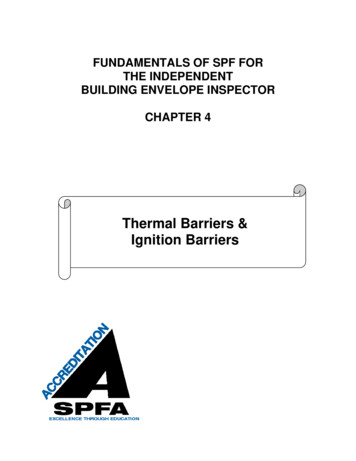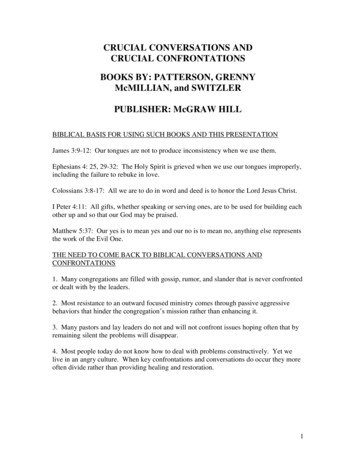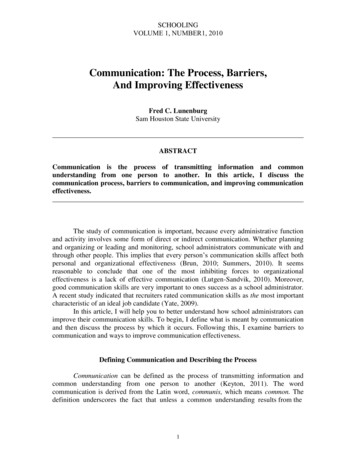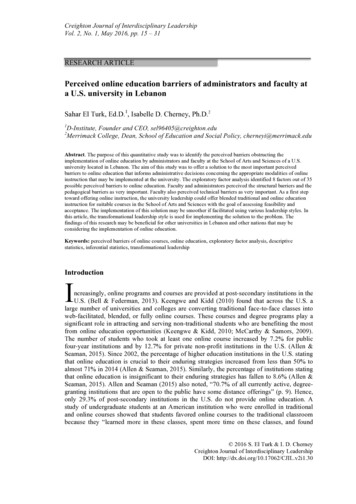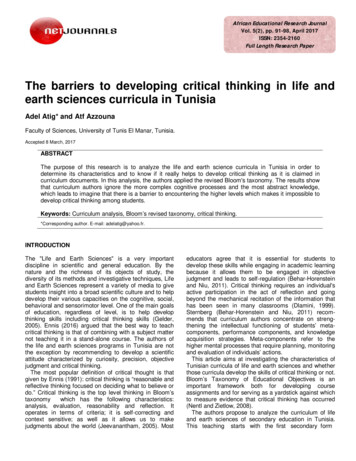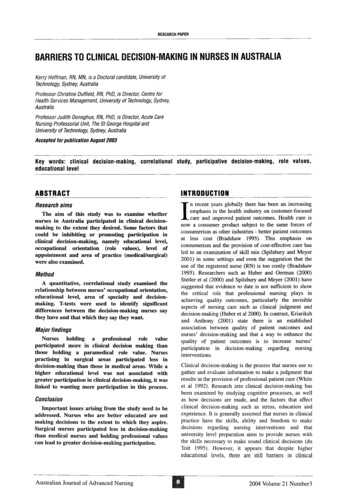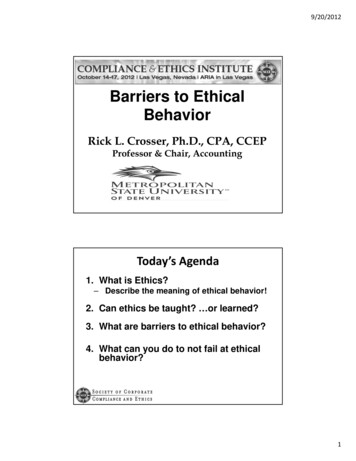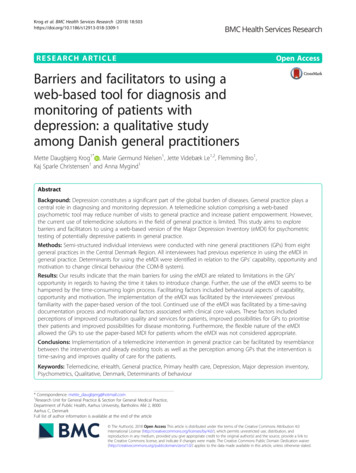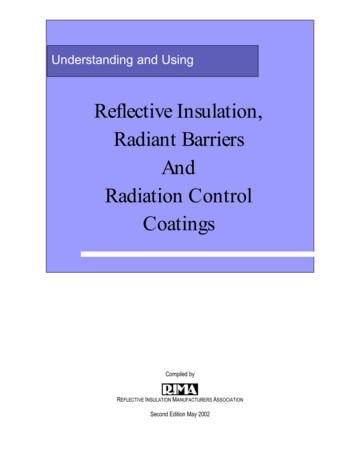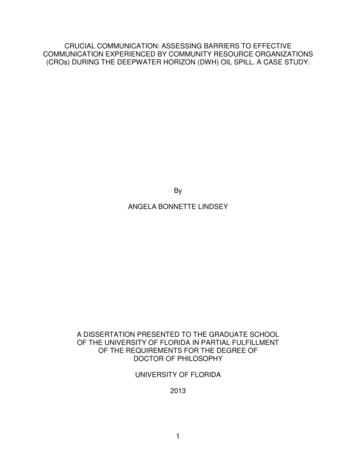
Transcription
CRUCIAL COMMUNICATION: ASSESSING BARRIERS TO EFFECTIVECOMMUNICATION EXPERIENCED BY COMMUNITY RESOURCE ORGANIZATIONS(CROs) DURING THE DEEPWATER HORIZON (DWH) OIL SPILL. A CASE STUDY.ByANGELA BONNETTE LINDSEYA DISSERTATION PRESENTED TO THE GRADUATE SCHOOLOF THE UNIVERSITY OF FLORIDA IN PARTIAL FULFILLMENTOF THE REQUIREMENTS FOR THE DEGREE OFDOCTOR OF PHILOSOPHYUNIVERSITY OF FLORIDA20131
2013 Angela Bonnette Lindsey2
To my husband Wade and my three sons, Cooper, Greyson, and ThadThank you for your patience, support, and love. I love you.3
ACKNOWLEDGMENTSAchieving this goal would not have been possible without the support andguidance of many people. A simple thank you seems inadequate to express mygratitude to each person that helped me achieve this milestone.To begin, I would like to thank the Florida Panhandle organizations that werewilling to take part in my study. I thank them for the giving of their time and theirresources. Many of them spent several hours answering questions and providinginformation. I am grateful to all of them and thank them for their contributions.I would also like to thank the Healthy Gulf, Healthy Communities team for theirsupport, guidance, and suggestions. This includes Dr. Sam Mathews, who assisted inhelping to develop my research questions and instrument.No great accomplishment comes without the encouragement and guidance ofothers. Given this, I would like to thank my advisor and friend, Dr. Tracy Irani who hasguided me, supported me, and encouraged me throughout this process. Dr, Irani hastirelessly worked and shown great patience in helping me to develop my researchinterests and molding my research goals. She has been instrumental in helping meremember to put on my academic hat when my practitioner hat was more comfortable.Dr. Irani is a gifted innovative researcher and communicator. I have been blessedto work with her in developing several successful programs and projects and amthankful to be included. Her dedication to the field of science communication issomething that I have admired and have greatly learned from over the past four plusyears. I have, and continue to, learn so much from Dr. Irani and am honored to have theopportunity to continue my work with her. She has been my rock and I am eternallygrateful. I thank her for her faith in me and only hope that I can one day return the favor.4
I would also like to thank my supervisory committee: Dr. Linda Hon, Dr. RickyTelg, and Dr. Hannah Carter. Their patience and encouragement to complete this studywas instrumental. The wisdom gained from each of them in and out of the classroomwill be with me for the rest of my life.I would like to thank Dr. Linda Hon for her willingness to serve as my outsidecommittee member. Dr. Hon is internationally known for her contributions to the field ofpublic relations, and I was both honored and humbled to have her serve as a committeemember. Dr. Hon’s suggestions and comments greatly enhanced my study, and I amgrateful for her efforts in not only helping to shape my research questions, but forsteering my results into a contribution to the field. The coursework provided by Dr. Honoriginally sparked my research interest and eventually led to my research plan. I thankher for teaching with passion and for instilling that same passion into me.In addition to serving on my committee, I was a teaching assistant to Dr. RickyTelg for several years. I would like to thank him for serving as a committee member andfor helping me develop my research by constantly reminding me to “write on what youknow”. I also thank him for helping me become a more effective teacher. By serving ashis teaching assistant for many years, I quickly learned the gold standard for professorsand for advisors. His teaching strengths and talents are ones that I aspire to reach oneday, and I thank him for giving me the opportunity to learn from him.From Dr. Hannah Carter, I have learned to be a better student, researcher, friend,teacher, and leader. I thank her for her service as a committee member and for heropen-door policy, which I probably abused. Consistently through his process, Dr. Carterhas provided me with support, encouragement, friendship, and often a pillow! She5
patiently and actively listened to concerns and problems and always took the time toprovide words of advice. Dr. Carter’s work makes an impact on communities around theworld. I have marveled at her ability to turn research into practice by empoweringpeople. She has impacted lives and communities by her work, which has been aninspiration in my own work. It has been both an honor and a privilege to work with her,and I greatly thank her for her support and friendship.In addition to my committee, I would like to thank my family and friends for pushingme to fulfill my life-long dream and then serving as my cheerleaders every step of theway. Completing this journey would not have been possible without them.I am very lucky to have the love and support of many friends. Amy and ChrisWalker, Beth and Jay Neale, Kim Delp, Renee McCaslin, Samatha and Brian Snyder,Susan Danhauser, Giselle Auger, Jennifer Cox, Joy Rogers, Alexa Lamm, Lauren Aull,Heather Branum, Windy Griffin, Christy Chiarelli, Lauri Baker, Quisto Settle, DeidraSlough, Sebastian Galindo, April Blazejewski, Gene Rodrick, Alison Watson, and manyothers always managed to keep my spirits and motivation up. I thank them for theirconstant support and encouragement.I would also like to thank my parents, Jan and Gerry Bonnette, for always believingin me and teaching me the value of an education. They have served as cheerleaders,therapists, editors, and babysitters during this process. I am blessed to have wonderfulparents and thank them for always reminding me that failure was not an option.Although my children Cooper, Greyson, and Thad did not fully grasp what I wasdoing in Gainesville for the past four years, I thank them for their patience, support,love, and understanding. It is my sincere hope that by reaching this goal, I teach them6
the importance of an education and instill in them that they can do anything with will,determination, and hard work.Finally, I would like to thank my husband Wade, who may be more happy thananyone that this chapter is finally coming to a close. Without Wade, reaching thismoment would not have been possible. I thank him for his patience, support, sacrifice,guidance, and love. Wade sacrificed his personal work and goals to take care of ourfamily. The words thank you will never seem enough to show my gratitude. My hope isthat one day, I can provide the same support to him.7
TABLE OF CONTENTSpageACKNOWLEDGMENTS . 4LIST OF TABLES . 11LIST OF FIGURES . 12LIST OF ABBREVIATIONS . 13ABSTRACT . 14CHAPTER1INTRODUCTION . 16Communication within Organizations . 17Communicating during a Crisis . 18Effective Communication . 20Barriers to Effective Communication . 21DWH Oil Spill . 22Why Study the DWH Oil Spill? . 24Communication and the Deepwater Horizon Oil Spill . 25Economic and Environmental Impacts . 27Psychological Impacts . 28Complexity of the Deepwater Horizon Oil Spill . 29Community Resource Organizations . 32Organizations Involved in the DWH Oil Spill . 34Florida Extension . 35Additional Organizations. 36Significance of the Study . 39Research Questions . 402LITERATURE REVIEW . 42Effective Communication . 42Barriers to Effective Communication . 44Science Communication . 46Two-Way Symmetrical Model of Public Relations . 47Excellence Theory . 48Crisis Theory. 51Crisis Management . 53Situational Crisis Communication Theory . 54Disaster Communication . 56Defining Issues Management . 57Issues Management during a Crisis . 588
Jaques’ Issue and Crisis Management Relational Model . 59Planning Processes . 61Systems and Manuals . 61Training and Simulations . 61Early Warning Scanning . 62Issue and Risk Management . 62Emergency Response . 62Crisis Recognition . 62System Activation/Response . 63Crisis Management . 63Recover, Business Resumption . 63Post-Crisis Issue Impacts . 64Evaluation Modification . 64Issues Management and the DWH Oil Spill. 64Systems Theory . 66Collaboration Theory. 673METHODS . 73Qualitative Research. 73Case Study . 75Research Design . 78Primary and Secondary Data . 79Building on Case Study Research . 80Case Material. 81In-Depth Interviews . 81Healthy Gulf, Healthy Communities Regional Forum . 83Supporting Documents . 84Instrument . 85Data Analysis . 85Subjectivity Statement . 874RESULTS . 89The DWH Oil Spill as a Case Study . 89In-Depth Interview Participants .
Many of them spent several hours answering questions and providing information. I am grateful to all of them and thank them for their contributions. I would also like to thank the Healthy Gulf, Healthy Communities team for their support, guidance, and suggestions. This includes Dr. Sam Mathews, who assisted in helping to develop my research questions and instrument. No great accomplishment .
